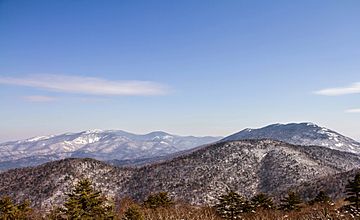Sikhote-Alin facts for kids
Quick facts for kids Sikhote-Alin |
|
|---|---|

Sikhote-Alin is the home to the Amur tiger, which is amongst the largest felines in the world
|
|
| Highest point | |
| Peak | Tordoki Yani (Russia) |
| Elevation | 2,090 m (6,860 ft) |
| Geography | |
| Official name: Central Sikhote-Alin | |
| Type: | Natural |
| Criteria: | x |
| Designated: | 2001 (25th session) |
| Reference #: | 766 |
| Region: | Europe and Asia |
The Sikhote-Alin (Russian: Сихотэ́-Али́нь, Russian pronunciation: [sʲɪxɐˈtɛ ɐˈlʲinʲ], English: /ˈsiːkəˌteɪ əˈliːn/, SEE-kə-TAY-_-Ə-leen) is a mountain range in Primorsky and Khabarovsk Krais, Russia, extending about 900 kilometres (560 mi) to the northeast of the Russian Pacific seaport of Vladivostok. The highest summits are Tordoki Yani at 2,077 metres (6,814 ft) above sea level, Ko Mountain (2,003 metres (6,572 ft)) in Khabarovsk Krai and Anik Mountain (1,933 metres (6,342 ft)) in Primorsky Krai.
Geography
Sikhote-Alin is a temperate zone, though species typical of northern taiga (such as reindeer and the Ussuri brown bear) coexist with the Amur tiger, Amur leopard, and Asiatic black bear. The region holds very few wolves, due to competition with tigers. The longest-lived tree in the region is a millennium-old Japanese yew.
Many tributaries of the Amur River lie within the range, including the Gur.
The core zone can only be explored in a company of rangers.
History
The name is thought to be of Manchu origin (Manchu: alin "mountain").
In the 1910s and 1920s, Sikhote-Alin was extensively explored by Russian geographer and naturalist Vladimir Arsenyev (1872–1930), who described his adventures in several books, notably Dersu Uzala (1923), which in 1975 was turned into an Oscar-winning film by Akira Kurosawa. Largely due to his exploration and advocacy, the large Sikhote-Alin and Lazo wildlife refuges were set up in 1935 to preserve the region's unusual wildlife.
On February 12, 1947, one of the largest meteorite showers in recent history occurred in the mountains range. The Sikhote-Alin meteorite exploded in the atmosphere as it fell, raining many tons of metal on an elliptical region about 1.3 square kilometres (0.50 sq mi) in area. Craters were formed by the meteorites; the largest was 26 metres (85 ft) in diameter.
In 2001, UNESCO placed "Central Sikhote-Alin" onto the World Heritage List, citing its importance for "the survival of endangered species such as the scaly-sided (Chinese) merganser, Blakiston's fish-owl and the Amur tiger". The World Heritage Site had a total area of 16,319 square kilometres (4,033,000 acres), of which the terrestrial core zone of Sikhote-Alin Zapovednik comprised 3,985 square kilometres (985,000 acres). In 2018, the World heritage Site was expanded by 11,605 square kilometres (2,868,000 acres) by including Bikin National Park under the name "Bikin River Valley".
See also
 In Spanish: Sijoté-Alín para niños
In Spanish: Sijoté-Alín para niños


